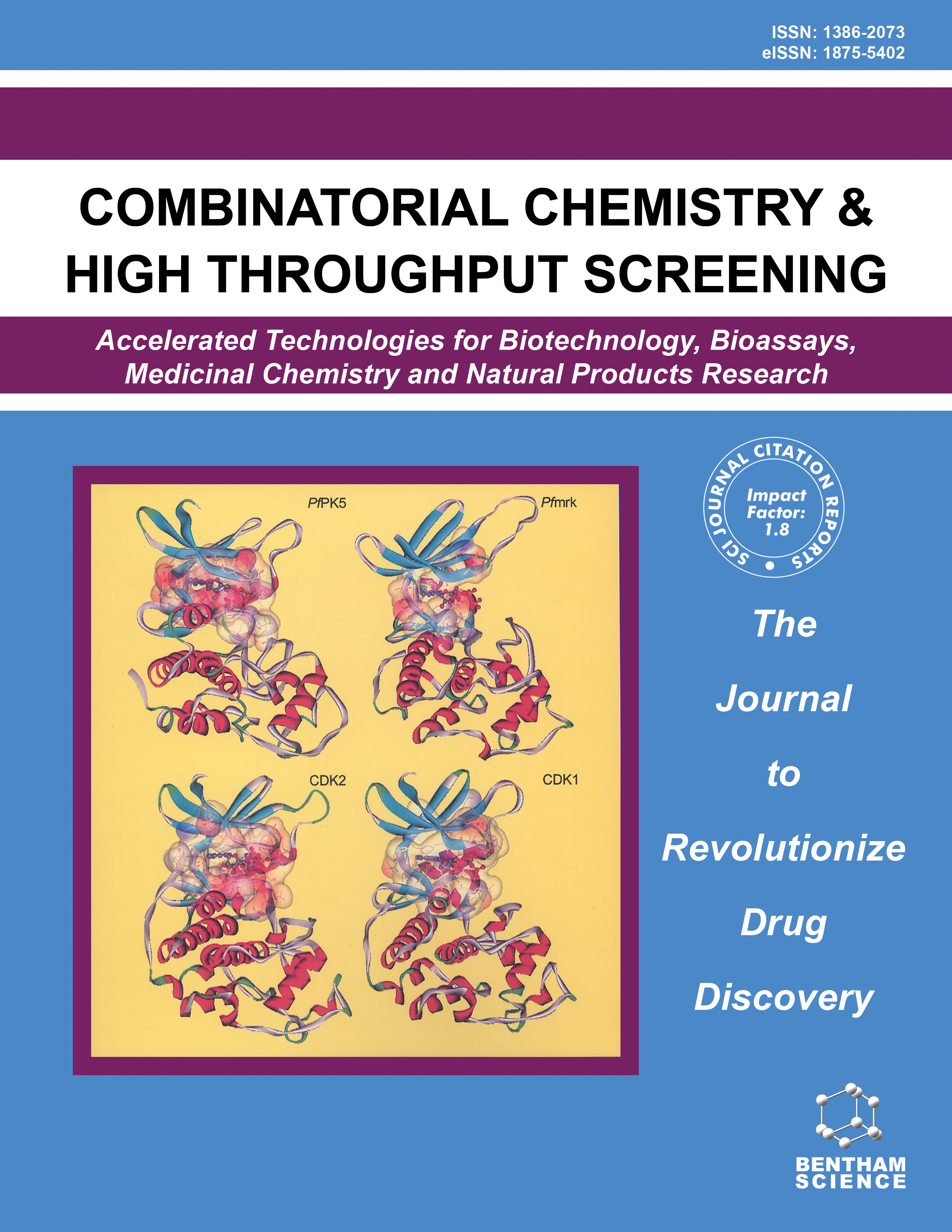- Home
- A-Z Publications
- Combinatorial Chemistry & High Throughput Screening
- Previous Issues
- Volume 7, Issue 8, 2004
Combinatorial Chemistry & High Throughput Screening - Volume 7, Issue 8, 2004
Volume 7, Issue 8, 2004
-
-
High Throughput Screening of Genetic Polymorphisms by Matrix-Assisted Laser Desorption Ionization Time-of-Flight Mass Spectrometry
More LessAuthors: Giuseppe Corona and Giuseppe ToffoliIn the post genomic era, the screening of many different genetic polymorphisms in large populations represents a major goal that will facilitate the understanding of individual genetic variability in the development of multi factor diseases and in drug response and toxicities. The increasing interest in these pathogenetic and pharmacogenomic studies by both academic and pharmaceutical industry researchers has increased Read More
-
-
-
Multiplexed RT- PCR for High Throughput Screening Applications
More LessAuthors: Derrick Maley, Jay Mei, Hong Lu, Dana L. Johnson and Sergey E. IlyinTo increase efficiency of high throughput gene expression profiling, we established a new TaqMan RT-PCR (real-time reverse transcriptase-polymerase chain reaction with internal probes for the quantification of PCR products) method for quantitative mRNA expression analysis. In this procedure, we utilized poly-A mRNA capture plates and validated a multiplexed single tube RT-PCR assay for cell culture applications, inc Read More
-
-
-
Anti-Endotoxin Agents. 2. Pilot High-Throughput Screening for Novel Lipopolysaccharide-Recognizing Motifs in Small Molecules
More LessAuthors: Stewart J. Wood, Kelly A. Miller and Sunil A. DavidLipopolysaccharides (LPS), otherwise termed 'endotoxins', are an integral part of the outer leaflet of the outer-membrane of Gram-negative bacteria. Lipopolysaccharides play a pivotal role in the pathogenesis of 'Septic Shock', a major cause of mortality in the critically ill patient, worldwide. The sequestration of circulatory endotoxin may be a viable therapeutic strategy for the prophylaxis and treatment of Gram-n Read More
-
-
-
High Throughput Screening of β-Amyloid Secretion Inhibitors Using Homogenous Time-Resolved Fluorescence
More LessA cell-based assay using homogeneous time-resolved fluorescence has been developed for high throughput screening of putative β-amyloid (Aβ)production inhibitors. In this assay, total Aβ is detected by simply adding two commercially available antibody complexes. The first was a biotinylated monoclonal antibody (4G8), specifically recognizing an epitope comprising the residues 17-24 of the Aβ peptide, complexed Read More
-
-
-
Ligand.Info Small-Molecule Meta-Database
More LessAuthors: Marcin v. Grotthuss, Grzegorz Koczyk, Jakub Pas, Lucjan S. Wyrwicz and Leszek RychlewskiLigand.Info is a compilation of various publicly available databases of small molecules. The total size of the Meta-Database is over 1 million entries. The compound records contain calculated threedimensional coordinates and sometimes information about biological activity. Some molecules have information about FDA drug approving status or about anti-HIV activity. Meta-Database can be downloaded from the http: / / Ligand.Info Read More
-
-
-
Peptide Protein Binding Assay Using ImageFlashPlates or Imaging Beads
More LessAuthors: Susanne E. Merk, Hans-Dieter Schubert, Werner Moreth, Martin J. Valler and Ralf HeilkerImaging devices used for the measurement of radioligand-receptor binding assays are typically based on charge-coupled device (CCD) cameras, which are more sensitive for red-shifted scintillation. In the past, red-shifted scintillants had only been integrated into microspheres, referred to as scintillation proximity assay (SPA) Imaging Beads+. More recently, ImageFlashPlates+ have been developed that emit light at 615 nm w Read More
-
-
-
Molecular Diversity Management Strategies for Building and Enhancement of Diverse and Focused Lead Discovery Compound Screening Collections
More LessAuthors: A. Schuffenhauer, M. Popov, U. Schopfer, P. Acklin, J. Stanek and E. JacobyThis publication describes processes for the selection of chemical compounds for the building of a high-throughput screening (HTS) collection for drug discovery, using the currently implemented process in the Discovery Technologies Unit of the Novartis Institute for Biomedical Research, Basel Switzerland as reference. More generally, the currently existing compound acquisition models and practices are discussed. Our informat Read More
-
-
-
Normalization of cDNA Microarray Data Using Wavelet Regressions
More LessAuthors: Ju Wang, Jennie Z. Ma and Ming D. LiNormalization is an essential step in microarray data mining and analysis. For cDNA microarray data, the primary purpose of normalization is removing the intensity-dependent bias across different slides within an experimental group or between multiple groups. The locally weighted regression (lowess) procedure has been widely used for this purpose but can be comparatively time consuming when the dataset beco Read More
-
-
-
Probability Issues in Molecular Design: Predictive and Modeling Ability in 3D-QSAR Schemes
More LessAuthors: Jaroslaw Polanski, Rafal Gieleciak and Andrzej BakIn the current work we investigated 3D-QSAR data by the use of the coupled leave-several-out (LSO) and leave-one-out (LOO) cross-validation (CV) procedures. We verified the above mentioned scheme using both simulated data and real 3D QSAR data describing a series of CoMFA steroids, heterocyclic azo dyes and styrylquinoline HIV integrase inhibitors. Unlike in standard analyses, this technique characterizes individual me Read More
-
Volumes & issues
-
Volume 28 (2025)
-
Volume 27 (2024)
-
Volume 26 (2023)
-
Volume 25 (2022)
-
Volume 24 (2021)
-
Volume 23 (2020)
-
Volume 22 (2019)
-
Volume 21 (2018)
-
Volume 20 (2017)
-
Volume 19 (2016)
-
Volume 18 (2015)
-
Volume 17 (2014)
-
Volume 16 (2013)
-
Volume 15 (2012)
-
Volume 14 (2011)
-
Volume 13 (2010)
-
Volume 12 (2009)
-
Volume 11 (2008)
-
Volume 10 (2007)
-
Volume 9 (2006)
-
Volume 8 (2005)
-
Volume 7 (2004)
-
Volume 6 (2003)
-
Volume 5 (2002)
-
Volume 4 (2001)
-
Volume 3 (2000)
Most Read This Month
Article
content/journals/cchts
Journal
10
5
false
en

Most Cited Most Cited RSS feed
-
-
Label-Free Detection of Biomolecular Interactions Using BioLayer Interferometry for Kinetic Characterization
Authors: Joy Concepcion, Krista Witte, Charles Wartchow, Sae Choo, Danfeng Yao, Henrik Persson, Jing Wei, Pu Li, Bettina Heidecker, Weilei Ma, Ram Varma, Lian-She Zhao, Donald Perillat, Greg Carricato, Michael Recknor, Kevin Du, Huddee Ho, Tim Ellis, Juan Gamez, Michael Howes, Janette Phi-Wilson, Scott Lockard, Robert Zuk and Hong Tan
-
-
- More Less

